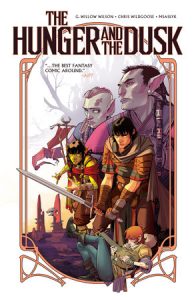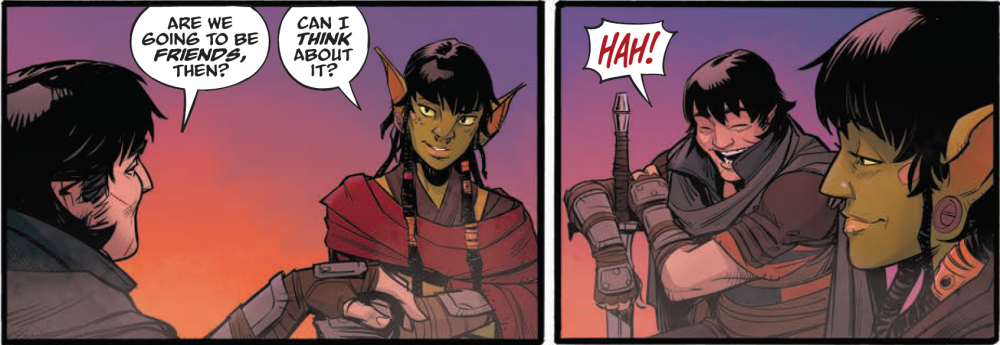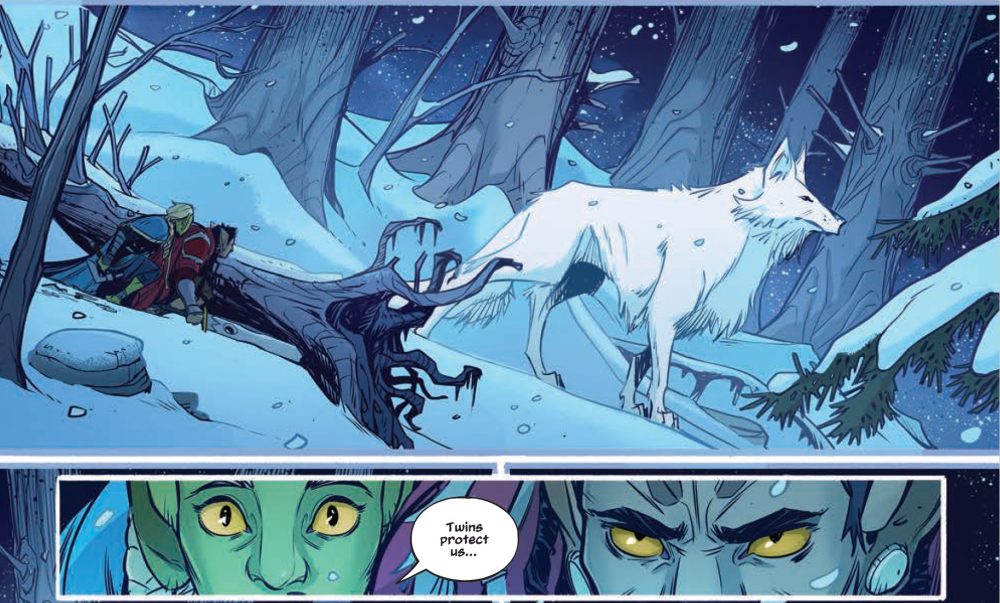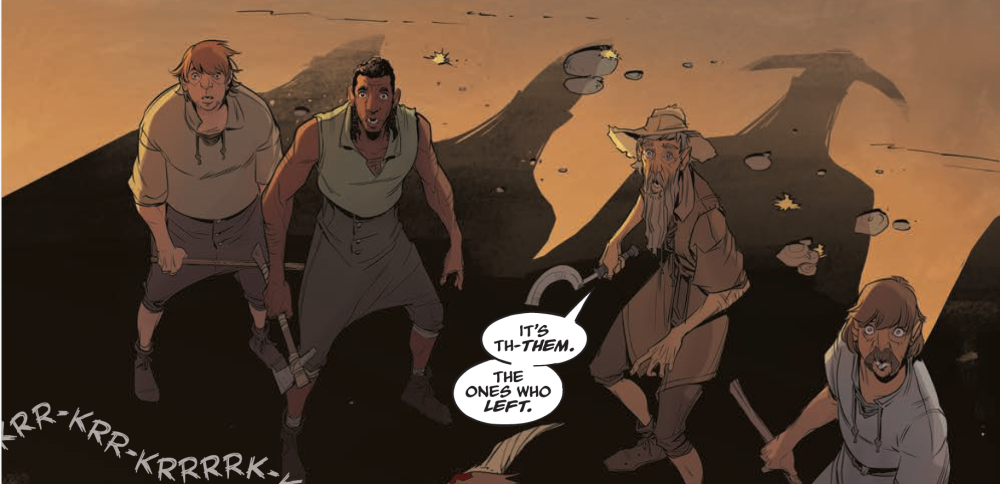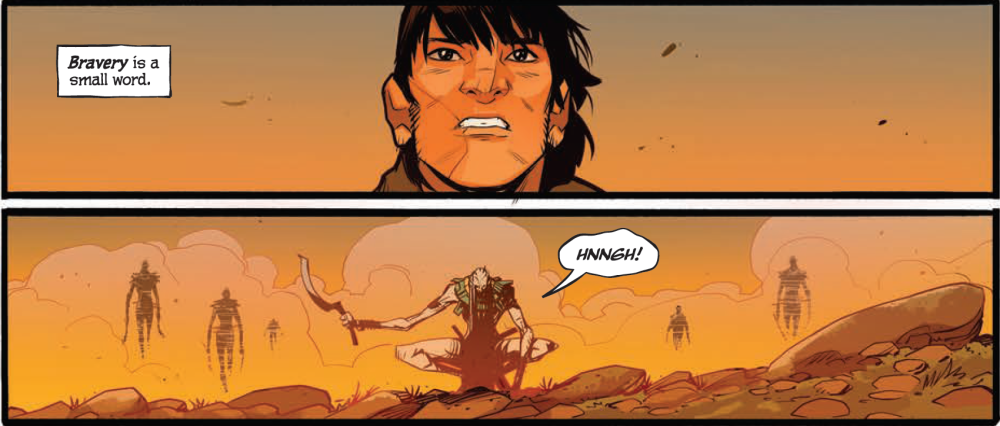
The Hunger and the Dusk, Vol. 1
Writer: G. Willow Wilson
Artist: Chris Wildgoose
Colorist: Msassyk
Letterer: Simon Bouland
Color Assistant: Diana Sousa
Publisher: IDW Publishing
J.R.R. Tolkien’s The Lord of the Rings is both a gift and a curse to the fantasy genre. Its many pleasures — imaginary languages, lovable characters, a deep sense of melancholy — have been praised by readers since its 1954 publication. Yet with those pleasures come foibles: racial essentialism, a simplistic good versus evil framework, and the baggage of “restoration fantasy” which necessitates kings returning to their thrones. Some authors like Ursula Le Guin challenged that framework in their time. Others blindly reproduced it. The bulk of popular epic fantasy retains Tolkien’s worst traits.
How do you spin your own tale in the tradition of Tolkien and his followers without making the same mistakes? The Hunger and the Dusk takes the logical approach and flips Tolkien on its head. The elves traveled to the West and now they’re the bad guys. The orcs are not monsters but are instead established royalty with a rich cultural history. Humans are unreliable cattle farmers on the verge of dissolution. Only orcs and humans together stand a chance against the elves.
The core of the story is not battle but romance. The mercenary Callum Battlechild forms an alliance with the orc healer Gruakhtar “Tara” Icemane. They fall in love as they wage a war against elves across the South. Meanwhile, Tara’s cousin Troth works with his wife Faran in the North to preserve the fragile alliance between orcs and humans. While Callum is the first named character we meet, he is outnumbered by the orcs in the story. They are the true movers and shakers of this setting.
G. Willow Wilson has happily admitted in interviews to being inspired by World of Warcraft. Orcs have played a role in that franchise since the first Warcraft game in 1994. Their first appearances tended towards Tolkenien essentialism. Yet they became increasingly defined as Blizzard Entertainment fleshed out their pulpy world of Astaroth. Wilson and the book’s artist Chris Wildgoose take that process one step further. They assert the place of orcs in their narrative from the beginning, rather than arriving there by accident.
The world of The Hunger and the Dusk is in decline just like Middle Earth. The crops are failing, orcs are running out of food and humans lack organized government. Dwarves are extinct. The elves, by their own account, “crossed the sea and found only doom.” There are clear parallels to our own world. Extreme heat waves in India sickened and killed many through the election season. That’s just the last reported example of an unevenly distributed worldwide climate crisis.
The disappearance of magic in Middle Earth is portrayed as a necessary separation — a means of moving elves and other creatures out of the picture so that humans may take their place. Wilson and her crew, though, come to a very different conclusion in The Hunger and the Dusk than Tolkien. It is not enough for orcs and humans to die separately. They must band together, and hope that whatever remnants that survive may pass their stories along. It’s a distinctly 2020s message for a 2020 audience.
The Hunger and the Dusk is not the first “post-apocalyptic” fantasy comic. Spurrier and Matías Bergara’s Coda beat it to the punch back in 2018. Despite sharing some of the same visual ideas, though, The Hunger and the Dusk leaves a very different impression. I think Msassyk’s colors are responsible. Every scene takes place at sunset or twilight, dying the world in fading hues. The effect is cozy but desolate. It is fantasy as transitory state, the last breath before the world shifts.
There’s much to recommend this book, and I expect that it will be well received by comics fans and fantasy readers. The fact that I was left unmoved has less to do with its qualities and more to do with my own preferences. I read fantasy hoping for novelty, or at least for a fresh take on old ideas. Every one of The Hunger and the Dusk‘s tricks, from its Warcraft-inspired orcs to its found family of rag-tag mercenaries, is borrowed from somewhere else.
I couldn’t help but be reminded of one of the better fantasy novels I’ve read lately, The Last Blade Priest by W.P. Wiles. Not only does it have a way nastier take on evil elves, but it also has giant talking vultures as well as tangents about architecture and religious fanaticism. The traditional fantasy elements are enriched by the author’s own interests, which come from outside the genre. This is what separates a great genre book from a merely good one.
The Hunger and the Dusk by comparison lives within its means. The characters are likable but never surprising. The world they inhabit has the right atmosphere but no sense of strangeness. The book’s urgent and important messaging–that people across the world must band together against an existential threat–is delivered in a conservative manner, artistically.
I blame Dungeons & Dragons. The tabletop roleplaying game is now at the height of its cultural influence. It has undoubtedly popularized fantasy as a medium and allowed for a wide audience to imagine their own worlds. Yet it has also flattened the genre. Many pieces of The Hunger and the Dusk, from its long-suffering mercenary bard to its bloody scenes of violence, read as homage to actual play rather than coherent fantasy worldbuilding.
The cliches of genre fiction are a tool in the writer’s box. At their best they are a means of establishing and then defying expectations. At their worst, they’re a foreclosure of possibility. The Hunger and the Dusk does a great job using Tolkien’s toys towards the right ends. It never does anything new with them. Nothing here measures up to the structural and or technical ambition of contemporary fantasy classics like Simon Jimenez’s The Spear Cuts Through Water or R.F. Kuang’s Babel. I expect more from this creative team.
Of course, the second and last volume of this series may change this. I’m curious to see where the climax of the first volume might lead. Will there be a hopeful ending, or will the cast’s dream of peace be deferred across generations? I’m open to being surprised. At this moment, though, I’m left thinking this is a handsome work with plenty to offer others — but not me.
The Hunger and the Dusk, Volume 1 is now available from IDW in both physical and digital formats.
Related
Discover more from reviewer4you.com
Subscribe to get the latest posts to your email.
